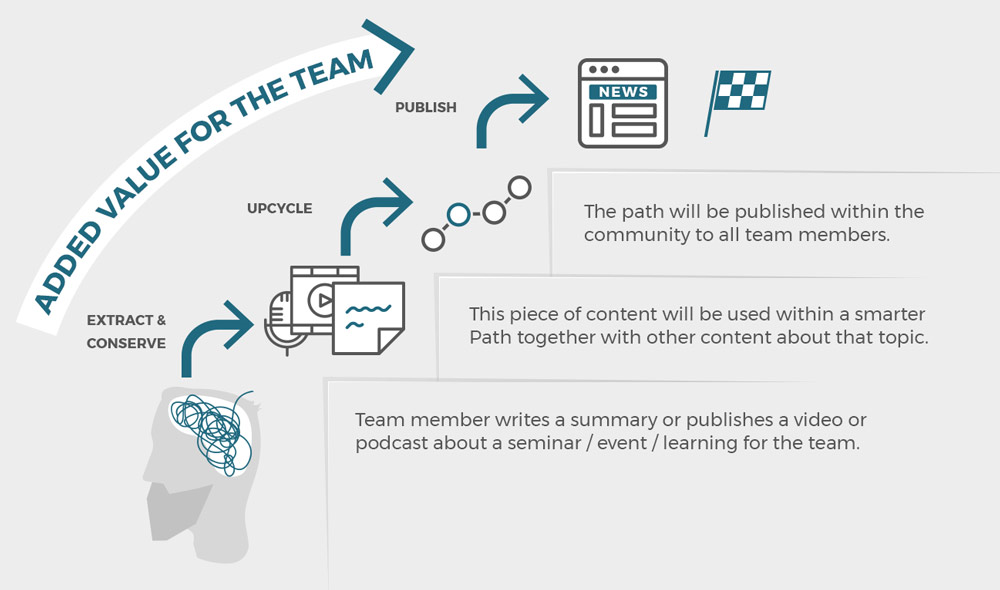We do live in a wonderful world. Most of the companies I know have a lot of tools to help their employees do their work. Especially where knowledge is the basis of their business, modern ESN (Enterprise Social Networks) offer the opportunity to share everything employees needs to share.
I see the risk, especially in knowledge-centric industries, that employees face a flood of information. Just information, not valuable content.
The bigger a community is and the longer it exists, the harder it is to get all of the pieces together to get an overall view of a topic. There is information in groups, Teamsites and OneDrive documents, in E-Mails and even in messages and streams. And of course in the heads of all employees.
Employees, as well as the management, need a way to extract and make this information more valuable through an upcycling process. The goal is to create smarter paths through this forest of information and emphasize the parts which are necessary and helpful to other employees. In my eyes, only valuable content creates benefit.
What is “valuable content” and why do companies need to think about it?
I would like to use some terms from the field of content marketing:
“[The word] ‘Value’ will inevitably mean something different depending on where your intended audience is on their journey, but relevant, consistent, engaging, trustworthy, useful, and authentic still matter the same.” (Source Überflip)
I like this definition from Überflip because the author thought about the meaning of value as something which doesn’t mean the same thing to different people. Furthermore he asks:
- “Relevant” — Is it right for your audience?
- “Consistent” — Does it align with your audience’s expectations?
- “Engaging” — Is it an enjoyable experience overall?
- “Trustworthy” — Is it believable”?
- “Useful” — Does it benefit your audience right now?*
- “Authentic” — Does it prove you are human?”
I’m not naive. I know that employees often don’t have the time to think about these requirements when they create information in their daily business. But in my eyes, the company has the responsibility to create more value out of this information if they want people to learn from each other and acquire the knowledge they need at the time they want it. Organisations should provide their employees and partners with easy to build and follow SmarterPathes through the flood of information.
Four steps of content upcycling
Companies should think about these four steps to get more valuable, better content:
- Extract Content: Before I talk about upcycling content, Companies should ask themselves: “Do we really have and published all the knowledge we need?” Although people have the possibility to share information they sometimes don’t do it. They don’t want to, they can’t or they just forget. Barriers are widespread. Especially when employees leave the company they are mostly not willing to share something anymore. Companies face the same situation with employees going into retirement.
- Conserve Content: The spoken word often has sometimes a short half-life, in the case of news streams and messaging it is a bit longer, but not much. Companies have to find a way to conserve relevant information in such a way that it will survive a little longer.
- Upcycle Content: Over the lifecycle of a community more and more content will be created in different formats. It should be the claim of every company to take this content and bring value to it. This means to make it relevant, consistent, engaging, trustworthy, useful and authentic for most of their employees.
- Publish Content: It is necessary for valuable content to reach the right target audience. Companies should think about which content will be relevant to whom and invest in things like proper search optimization functionality.

The content upcycling process (by Pokeshot 2017)
What does content upcycling mean exactly?
The question how companies can extract and conserve knowledge from their employees is difficult and will not be answered within such a short blog article. Furthermore, I want to show how companies can use and make Information from varoius chats, streams, documents and teamsites more valuable. Once the content has been conserved in various channels, it can have different characteristics:
- The content already has a lot of value to a lot of people.
- The content only has value to a few people.
- The content is valuable but not all people can reach it (e.g. language barrier).
- The content itself has low value but together with other information is gets more valuable.
- The content is valuable but is in an undesirable format or is hard to access
- The content has no value to anybody
The “content upcycler” should think about the following:
- Can I take this content as it is or do I have to restructure/rewrite/summarize it (e.g. in a blog post)?
- Do I have to change the format of the content so that more people understand it? (e.g. create a video)
- Are there other content formats which would help to better communicate the topic (e.g. profiles, external sites, quizzes)?
- How can I structure this content into a smarter path so that people understand it easily and have all the information they need?
- Which content can I leave out because it has no value?
What I want to add at this point: not all content has to be recreated through the company. With the right tools it is possible to use existing information from your community (Jive, O365) and share it in smarter paths with every employee. Additionally, not all the time HR has the responsibility to spread knowledge within the company. Every employee should be able to prepare and share knowledge.
Conclusion
I believe that once the content has been upcycled and published, companies are able to reduce the flood of information employees have to face day by day and the time people have to spend searching for the right information. Also, I think that through valuable content people do learn faster and more efficiently. Valuable content that is easy to find and is enriched trough personal experiences can and will help people to understand a topic better, learn faster and put new skills into action as soon as possible. This is not only more effective, but – in the long run – a lot more sustainable!
 About the author:
About the author:
Sandra Brückner, who studied business informatics at the Technical University of Dresden, has worked as social business consultant since 2012. She joined the Berlin-based social business consultancy and technology provider Pokeshot in the beginning of 2014 and works since more than two years as Chief Procust Officer for all products.
Connect with us on facebook | twitter | LinkedIn | YouTube – we will keep you posted!
2 thoughts on “Four steps of content upcycling”
Comments are closed.